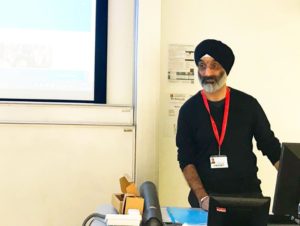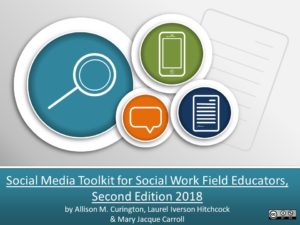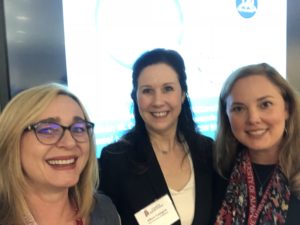360-degree immersive video apps: Why you should create meaningful research-based digital resources to engage learners

Editor’s Note: Dr. Tarsem Singh Cooner is a Senior Lecturer in the Department of Social Work and Social Care at the University of Birmingham. In this post, he describes why and how he developed 360-degree immersive video apps to create engaging learning opportunities for students. Additionally, his work shows how digital tools can be used to creatively disseminate research findings to practitioners. Dr. Cooner tweets at @Akali65. You can also email him at t.s.cooner@bham.ac.uk.
The background
Quite recently I was lucky enough to be part of a fantastic research project exploring factors that can either enable or create barriers to effective child protection social work. Our project had collected a lot of data that we were convinced could have a really positive impact on child protection services. To disseminate our research in a more accessible, meaningful, situated and impactful way, I led an initiative within the team to create a set of 360-degree immersive video apps that social work students and practitioners can download onto their smartphones via the iTunes and Google Play Stores. Using their phones with easily accessible 360-degree headsets (like Google’s Cardboard) they can become ‘immersed’ in our work through recreated scenes from our research experiences.
#SWDE2019 – A Toolkit for Social and Digital Media Policies in Field Education
It is the second day of the 2019 Social Work Distance Education Conference and at 10 AM, I’ll be in the Peraux Room of the St. Anthony Hotel to share our poster about the Social Media Toolkit for Field Educators. This is a project I have been working on with Allison Curington (University of Alabama), Mary Jacque Carroll (University of Alabama at Birmingham),and Robin Snider (Jacksonville State University). The poster will provide both information and tools that field directors can use to guide curricular development of learning approaches and assessment strategies to achieve practice outcomes. Participants will learn how to access the Social Media Toolkit for Field Educators, a free resource with educator’s guide and a PowerPoint slide deck.
If you can’t make it to the poster, I am included all the important details in this blog post.
Review of Teaching & Learning in Social Work for 2018
One of the reasons I like a good “end-of-the-year list” is the opportunity to reflect on what I did and did not miss out on over the past year. I’m always thrilled to discover I read one or maybe even two of the most notable books on the New York Times yearly list. Then, I start planning my reading wish list for the coming year, which usually involves magical thinking about reading every winner of the Nobel Prize for Literature or the all the Pulitzer Prize winners for Non-Fiction from the last ten years. Even if I don’t actually read all of these books, I believe in having some goals for my reading and other activities. For the Teaching and Learning in Social Work Blog, I had three goals for 2018:
1 .Write or publish 30 blog posts
2. Increase the number of blog subscribers from 100 to 200
3. Publish 10 guest educator blog posts
Here is how those goals worked out:
1. Wrote only 13 blog posts during the year, but published a total of 21 posts (70% completed)
2. Only added 40 more subscribers to the blog (40% completed)
3. Published 8 guest educators posts (80% completed)
While not all my goals were achieved, I was still able to collaborate with others to accomplish some solid writing for the blog including information about projects that I have been working on, and all my conference presentations for the year. Below is a list of this year’s posts, grouped around the topics of projects, guest educator posts, and conference presentations.
Projects: These posts describe new projects that I started or worked on during 2018:
#APM18 Helping Social Work Students develop a Professional Online Presence for Interprofessional Communication
On Thursday, November 8, 2018, I will be presenting with Allison Curington and Mary Jacque Carroll, both field directors extraordinaire, at the Field Education Institute at the Council on Social Work Education’s 2018 Annual Program Meeting. As part of the institute, we are facilitating a one hour on how field educators can help social work students develop a professional online presence for interprofessional communication. We will be sharing information and tools that field directors can use to guide curricular development of learning approaches and assessment strategies to achieve practice outcomes around interprofessional communication with digital and social technologies. One of the tools we will be sharing is the second edition of Social Media Toolkit for Social Work Field Educators, which has been revised with content based on the 2018 NASW Code of Ethics.
You can access your free copy of the toolkit here: https://laureliversonhitchcock.org/2018/11/05/revised-social-media-toolkit/
Second Edition of the Social Media Toolkit for Social Work Field Educators
 We are pleased to announce the availability of the second edition of Social Media Toolkit for Social Work Field Educators (2018), which has been updated to address the recent changes to the Code of Ethics from the National Association of Social Workers.
We are pleased to announce the availability of the second edition of Social Media Toolkit for Social Work Field Educators (2018), which has been updated to address the recent changes to the Code of Ethics from the National Association of Social Workers.
This toolkit provides social work field educators with tools and resources to help social work students and field instructors assess, develop, and maintain an online identity for professional purposes. There are two parts to the toolkit – an Educator’s Guide and a PowerPoint Slide Deck. The Educator’s Guide provides directions, descriptions, and handouts related to the content of the toolkit while the Slide Deck includes pre-formatted slides with selected content for presenting in the classroom or a workshop. The content of this toolkit is divided into six different topics centered on how to use social media professionally as a social worker:
1. Ethical Considerations for Social Media Use in Social Work Practice
2. Reflecting on Social Media Use in Social Work Practice
3. Engaging and Self-Assessment with Social Media
4. Professional Practice with Social Media
5. Case Studies for Students & Field Educators
6. Social Media Learning Activities for Field Education
Specific content for these topic areas include learning activities about why, when, and how to use social media as a practicing social work professional; skills for managing an online identity; guidelines for developing one’s own professional social media policy; and case studies to help develop professional and ethical competency.
Student Placement Software for the Social Work Field Office: Goodbye Post-it Notes!
This month’s guest educator post comes from Kristen Samuels, MSW, MS, MEd, the Field Director for the University of Phoenix’s Department of Social Work. In this blog post, she reviews the “whys” and “hows” of selecting student placement software for your field education office. Kristen can be reached at Kristen.samuels@gmail.com, or @KristenMSamuels on Twitter.
Student placement software are valuable tools when managing the complex processes of Social Work Field Placement. These programs are often web-based and provide easy access for our students, field instructors, and administrators to gather and store information, submit documentation, and obtain reportable data. In reality, field offices often piece together multiple systems to meet all the office needs. This is often because of cost and program features – few affordable student placement programs address all of the needs for a typical field office. In the end, the most important components of student placement software and databases are functional communication between stakeholders, compliance with regulatory requirements, and ease of use.
 Endless platform options are available to manage the student placement process. Depending on the size of your program, your needs will vary, and depending on your budget, your options for platforms will vary. Some institutions are able to manage placements through home-grown efforts (i.e. they design their software in-house) or low-cost proprietary software, such as Google Drive applications, which not only encourage collaboration among the team but are also free to use. A spectrum of other proprietary platforms are available, with varying functionality and associated costs. On the low-cost end of the spectrum, software programs such as Intern Placement Tracking (IPT) allow for form submission (i.e. students and field supervisors complete learning agreements and evaluation forms online) to manage basic logistics, whereas larger programs like 2U provide a placement team with tools to manage a database of affiliated agencies, accreditation support, and more.
Endless platform options are available to manage the student placement process. Depending on the size of your program, your needs will vary, and depending on your budget, your options for platforms will vary. Some institutions are able to manage placements through home-grown efforts (i.e. they design their software in-house) or low-cost proprietary software, such as Google Drive applications, which not only encourage collaboration among the team but are also free to use. A spectrum of other proprietary platforms are available, with varying functionality and associated costs. On the low-cost end of the spectrum, software programs such as Intern Placement Tracking (IPT) allow for form submission (i.e. students and field supervisors complete learning agreements and evaluation forms online) to manage basic logistics, whereas larger programs like 2U provide a placement team with tools to manage a database of affiliated agencies, accreditation support, and more.
How to pick the program that is right for your Field Office?
It is important to develop your own list of needs based on your specific institution and the needs of your field office. Here are some questions to consider when developing that list:





